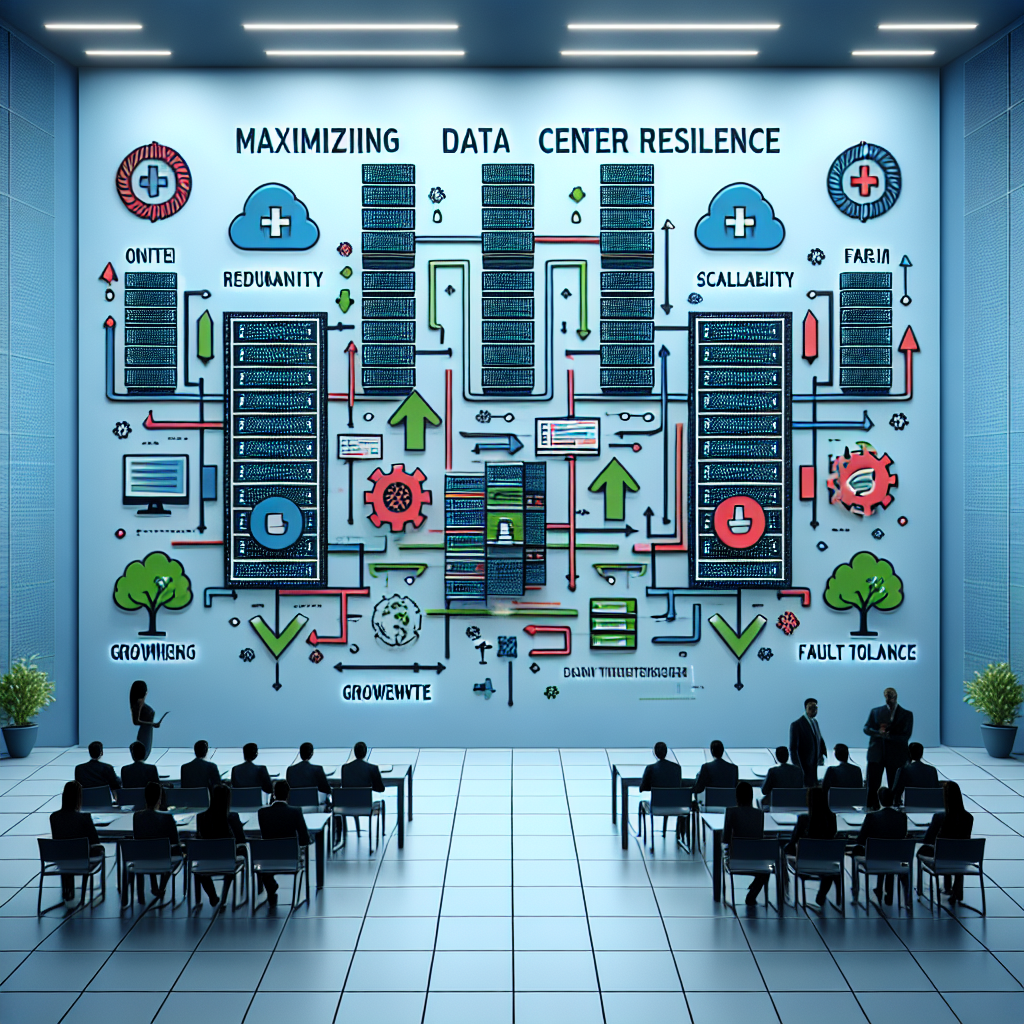Your cart is currently empty!
Tag: Scalability

Optimizing Data Center IT Operations for Scalability
In today’s digital age, data centers play a crucial role in supporting the operations of businesses of all sizes. As the volume of data continues to grow exponentially, it is essential for data center IT operations to be optimized for scalability. Scalability refers to the ability of a system to handle increased workload without compromising performance or availability. By optimizing data center IT operations for scalability, businesses can ensure that their infrastructure can grow with their needs and adapt to changing demands.There are several key strategies that businesses can utilize to optimize their data center IT operations for scalability. One of the most important steps is to design a flexible and modular infrastructure that can easily accommodate growth. This includes using virtualization technology to create virtual servers and storage resources that can be easily scaled up or down as needed. By decoupling hardware from software, businesses can avoid the need for costly hardware upgrades and downtime when expanding their infrastructure.
Another important aspect of optimizing data center IT operations for scalability is implementing automation and orchestration tools. These tools can help streamline and automate routine tasks, such as provisioning and managing resources, which can free up IT staff to focus on more strategic initiatives. By automating repetitive tasks, businesses can improve efficiency, reduce human error, and scale their operations more effectively.
In addition, businesses should also prioritize monitoring and analytics to gain insights into their data center performance and identify potential bottlenecks or areas for improvement. By implementing monitoring tools that provide real-time visibility into key performance metrics, businesses can proactively address issues before they impact operations. Analytics tools can also help businesses identify trends and patterns in their data center operations, enabling them to make data-driven decisions to optimize performance and scalability.
Lastly, businesses should consider leveraging cloud services and hybrid cloud solutions to enhance scalability. Cloud services offer on-demand access to resources that can be quickly scaled up or down based on business needs. By combining on-premises infrastructure with cloud services, businesses can create a flexible and scalable hybrid environment that can adapt to changing demands and provide greater agility.
In conclusion, optimizing data center IT operations for scalability is essential for businesses looking to adapt to the ever-changing digital landscape. By implementing flexible infrastructure, automation tools, monitoring and analytics, and cloud services, businesses can ensure that their data center operations can scale effectively to meet their evolving needs. By prioritizing scalability, businesses can future-proof their infrastructure and position themselves for success in the digital age.

Planning for the Future: Scalability and Flexibility in Data Center Lifecycle Management
In today’s fast-paced digital world, data centers play a crucial role in the success of businesses. As the demand for data storage and processing power continues to grow, it’s important for organizations to plan for the future by ensuring scalability and flexibility in their data center lifecycle management.Scalability is key when it comes to data center management. As businesses grow and evolve, their data storage and processing needs will also increase. It’s important to have a data center infrastructure that can easily scale to accommodate this growth without causing disruptions to operations. This means having the ability to add more servers, storage, and networking equipment as needed, as well as the ability to upgrade existing systems to meet the demands of the business.
Flexibility is another crucial aspect of data center lifecycle management. With technology constantly evolving, it’s essential for organizations to have a data center infrastructure that can adapt to new technologies and changing business requirements. This means having the ability to easily integrate new hardware and software, as well as the ability to reconfigure existing systems to meet the needs of the business.
One way to ensure scalability and flexibility in data center lifecycle management is to adopt a modular approach to infrastructure design. By breaking down the data center into smaller, more manageable modules, organizations can easily add or remove components as needed, without causing disruptions to operations. This allows for greater flexibility in adapting to changing business requirements, as well as the ability to scale the infrastructure to meet growing demands.
Another important aspect of planning for the future in data center lifecycle management is to regularly assess and optimize the performance of the infrastructure. This means monitoring key performance metrics, such as power consumption, cooling efficiency, and server utilization, and making adjustments as needed to improve efficiency and reduce costs. By continuously optimizing the performance of the data center infrastructure, organizations can ensure that they are able to meet the demands of their business while also minimizing their environmental impact.
In conclusion, planning for the future in data center lifecycle management requires a focus on scalability and flexibility. By adopting a modular approach to infrastructure design, regularly assessing and optimizing performance, and staying abreast of new technologies, organizations can ensure that their data center infrastructure is able to meet the demands of their business now and in the future. By taking proactive steps to plan for the future, organizations can position themselves for success in an ever-evolving digital landscape.

Maximizing Data Center Resilience: Tips for Improving Redundancy, Scalability, and Fault Tolerance
In today’s digital age, data centers play a crucial role in ensuring the smooth operation of businesses and organizations. These facilities house the servers and networking equipment that store and process vast amounts of data, making them the backbone of modern technology infrastructure. As such, it is essential for data centers to be resilient and able to withstand potential disruptions that could impact their operations.One of the key ways to maximize data center resilience is by improving redundancy. Redundancy refers to the duplication of critical components within the data center, such as power supplies, cooling systems, and networking equipment. By having redundant systems in place, data centers can continue to operate even if one component fails. This can help prevent costly downtime and ensure that data remains accessible to users.
To improve redundancy, data center operators can implement a dual-power supply system, where each server is connected to two separate power sources. This way, if one power source fails, the server can continue to operate using the backup power supply. Additionally, data centers can also implement redundant cooling systems and networking equipment to further enhance resilience.
Scalability is another important factor to consider when maximizing data center resilience. Scalability refers to the ability of a data center to expand or contract its resources based on changing demand. By designing a data center with scalability in mind, operators can ensure that the facility can easily adapt to increasing data loads without compromising performance.
To improve scalability, data center operators can implement modular designs that allow for the easy addition of new servers and storage units. This way, as demand for data storage and processing power grows, the data center can quickly scale up to meet these needs. Additionally, virtualization technologies can also help improve scalability by allowing for the efficient allocation of resources based on demand.
Fault tolerance is another critical aspect of data center resilience. Fault tolerance refers to the ability of a system to continue operating even if one or more components fail. By designing a data center with fault tolerance in mind, operators can minimize the risk of downtime and ensure that data remains accessible to users.
To improve fault tolerance, data center operators can implement redundant storage systems, such as RAID arrays, that can continue to operate even if one disk fails. Additionally, data centers can also implement failover mechanisms that automatically switch to backup systems in the event of a failure.
In conclusion, maximizing data center resilience requires a combination of redundancy, scalability, and fault tolerance. By implementing these strategies, data center operators can ensure that their facilities can withstand potential disruptions and continue to operate efficiently. Ultimately, investing in resilience can help protect the integrity of data and ensure the smooth operation of businesses and organizations in today’s digital world.

Scalability and Flexibility: How to Scale Your Data Center Storage Infrastructure
As technology advances and businesses grow, the need for scalable and flexible data center storage infrastructure becomes increasingly important. Scalability refers to the ability of a system to handle a growing amount of work or its potential to be enlarged to accommodate that growth. Flexibility, on the other hand, refers to the ability to adapt and change easily to meet different needs or circumstances.Scaling your data center storage infrastructure is crucial to ensure that your business can handle the ever-increasing amounts of data that are being generated and stored. With the rise of big data, IoT devices, and cloud computing, businesses need to be able to scale their storage infrastructure quickly and efficiently.
There are several key strategies that can help you scale your data center storage infrastructure effectively. One of the first steps is to assess your current storage needs and identify any bottlenecks or limitations in your existing infrastructure. This will help you determine the best approach to scaling your storage capacity.
One common strategy for scaling storage infrastructure is to implement a storage area network (SAN) or network-attached storage (NAS) solution. These technologies allow you to add additional storage capacity as needed, without disrupting your existing infrastructure. SAN and NAS solutions also offer advanced features such as data deduplication, data replication, and snapshotting, which can help improve performance and data protection.
Another important consideration when scaling your data center storage infrastructure is to ensure that your storage solution is flexible enough to adapt to changing business requirements. This may involve implementing a software-defined storage (SDS) solution, which allows you to dynamically adjust storage resources based on demand. SDS solutions also offer features such as automated tiering, which can help optimize storage performance and cost efficiency.
In addition to implementing the right technology solutions, it is also important to consider the physical aspects of your data center storage infrastructure. This includes factors such as power and cooling requirements, rack space availability, and cabling infrastructure. By carefully planning and designing your data center storage infrastructure, you can ensure that it is scalable and flexible enough to meet your business needs now and in the future.
Overall, scalability and flexibility are essential components of a successful data center storage infrastructure. By implementing the right technology solutions, planning for future growth, and ensuring that your infrastructure is designed to adapt to changing business requirements, you can build a storage infrastructure that can support your business needs for years to come.

The Benefits of Cloud-Based Data Center Monitoring: Enhancing Scalability and Flexibility
In today’s fast-paced digital world, businesses rely heavily on data centers to store and manage their critical information. With the increasing complexity and volume of data being generated every day, it has become essential for organizations to monitor and manage their data centers effectively in order to ensure optimal performance and reliability.One solution that is gaining popularity among businesses is cloud-based data center monitoring. This technology allows organizations to monitor their data centers remotely, giving them the flexibility to access and manage their data from anywhere in the world. In addition to remote access, there are several other benefits of cloud-based data center monitoring that are enhancing scalability and flexibility for businesses.
Scalability is a key advantage of cloud-based data center monitoring. With traditional on-premise monitoring solutions, businesses often face limitations in terms of scalability. As their data center grows in size and complexity, it becomes increasingly challenging to manage and monitor all the components effectively. Cloud-based monitoring solutions, on the other hand, are designed to scale seamlessly with the growth of a business’s data center. This means that organizations can easily add new servers, storage devices, or network components to their data center without worrying about outgrowing their monitoring solution.
Flexibility is another key benefit of cloud-based data center monitoring. With traditional monitoring solutions, businesses are often tied to a specific set of hardware and software tools that may not easily integrate with other systems or applications. Cloud-based monitoring solutions, on the other hand, offer a high degree of flexibility and customization. Businesses can choose from a wide range of monitoring tools and features that best suit their specific needs and requirements. Additionally, cloud-based monitoring solutions often offer integration with other cloud services and applications, allowing businesses to create a seamless and interconnected monitoring ecosystem.
In addition to scalability and flexibility, cloud-based data center monitoring also offers businesses improved reliability and performance. By leveraging the power of the cloud, organizations can ensure that their data center monitoring systems are always up-to-date and running smoothly. Cloud-based monitoring solutions often provide real-time alerts and notifications, allowing businesses to quickly identify and address any issues that may arise in their data center. This proactive approach to monitoring can help businesses prevent downtime and ensure the continuous availability of their critical data and applications.
Overall, the benefits of cloud-based data center monitoring are clear. By enhancing scalability and flexibility, businesses can effectively manage and monitor their data centers with ease. With improved reliability and performance, organizations can rest assured that their critical data is safe and secure. As the digital landscape continues to evolve, cloud-based data center monitoring will play an increasingly important role in helping businesses stay ahead of the curve and adapt to changing technology trends.

Scalability and Flexibility: Managing Big Data in Data Center Databases
As technology continues to advance at a rapid pace, the amount of data being generated and stored is growing exponentially. This influx of data has led to an increased demand for scalable and flexible data center databases that can effectively manage big data.Scalability and flexibility are two essential characteristics of a data center database that can accommodate the ever-growing volume of data being generated. Scalability refers to the ability of a database to handle an increasing amount of data without sacrificing performance. Flexibility, on the other hand, refers to the database’s ability to adapt to changing data storage and retrieval requirements.
Managing big data in data center databases requires a strategic approach that takes into account the scalability and flexibility of the database. There are several key factors to consider when designing a database system that can effectively handle big data:
1. Distributed architecture: A distributed architecture allows data to be stored and processed across multiple servers, increasing the database’s scalability. This approach also provides flexibility as new servers can be added to the system to accommodate additional data storage requirements.
2. Data partitioning: Data partitioning involves splitting data into smaller chunks that can be distributed across multiple servers. This approach helps improve query performance and enables the database to scale more effectively as data volume increases.
3. Indexing and optimization: Implementing efficient indexing and query optimization techniques can help improve the database’s performance and scalability. By optimizing queries and indexes, data retrieval can be accelerated, leading to better overall database performance.
4. Cloud-based solutions: Cloud-based database solutions offer scalability and flexibility by allowing organizations to easily scale their database resources up or down based on their requirements. Cloud-based databases also provide the flexibility to store and access data from anywhere, making them ideal for organizations with distributed teams.
5. Data compression and storage optimization: Data compression techniques can help reduce the storage space required for big data, improving the database’s scalability and performance. Additionally, implementing storage optimization techniques such as tiered storage can help organizations efficiently manage their data storage requirements.
In conclusion, managing big data in data center databases requires a strategic approach that focuses on scalability and flexibility. By implementing distributed architectures, data partitioning, efficient indexing and optimization techniques, cloud-based solutions, and data compression and storage optimization, organizations can effectively manage big data and ensure their databases can scale and adapt to changing data storage and retrieval requirements. Investing in a scalable and flexible database system is essential for organizations looking to effectively manage and leverage the vast amounts of data being generated in today’s digital age.

Maximizing Data Center Cabling for Scalability and Flexibility
Data centers are the backbone of modern businesses, housing the servers and networking equipment that power everything from online shopping to social media platforms. As businesses grow and evolve, their data center needs also change, requiring scalability and flexibility in order to keep up with increasing demands.One of the key components of a data center that can greatly impact scalability and flexibility is cabling. Properly designed and implemented cabling infrastructure can make a significant difference in the efficiency and performance of a data center, allowing for easy expansion and adaptation to changing requirements.
Maximizing data center cabling for scalability and flexibility starts with careful planning and design. It’s important to consider not only the current needs of the data center, but also future growth and technological advancements. This means choosing the right type of cabling, such as fiber optic or copper, that can support higher bandwidth and faster data transfer speeds.
In addition, organizing and managing cabling in a data center is crucial for scalability and flexibility. A well-structured cabling system makes it easier to add or move equipment as needed, without causing disruptions or delays. Proper labeling and documentation of cables can also save time and prevent errors when troubleshooting or making changes.
Using cable management tools and techniques, such as cable trays, racks, and ties, can help keep cables organized and easily accessible. This not only improves the aesthetics of the data center, but also helps prevent cable damage and interference, which can impact performance and reliability.
Furthermore, utilizing modular cabling solutions can also enhance scalability and flexibility in a data center. Modular cabling systems allow for easy upgrades and modifications, without the need to completely rewire the infrastructure. This can save time and money, while also reducing the risk of downtime during maintenance or upgrades.
Overall, maximizing data center cabling for scalability and flexibility requires careful planning, organization, and the use of innovative solutions. By investing in a well-designed and managed cabling infrastructure, businesses can ensure that their data center is equipped to handle future growth and adapt to changing technology trends.

Best Practices for Data Center Capacity Planning: Strategies for Scalability and Growth
In today’s digital age, data centers play a crucial role in storing and managing vast amounts of information for businesses of all sizes. As organizations continue to rely on data centers to support their operations, it’s essential for IT professionals to implement effective capacity planning strategies to ensure scalability and accommodate future growth.Capacity planning is the process of determining the resources needed to meet current and future demands for IT services. By accurately predicting future capacity requirements, organizations can optimize their data center infrastructure, minimize downtime, and avoid costly upgrades or migrations.
To help organizations effectively plan for data center capacity, here are some best practices to consider:
1. Understand current usage patterns: Before embarking on capacity planning, it’s important to have a clear understanding of your organization’s current data center usage patterns. Analyze historical data to identify trends in resource utilization, peak loads, and performance bottlenecks. This information will serve as a baseline for forecasting future capacity requirements.
2. Define performance metrics: Establish key performance indicators (KPIs) to measure the performance of your data center infrastructure. Monitor metrics such as CPU utilization, memory usage, storage capacity, and network bandwidth to identify areas of inefficiency and plan for capacity upgrades.
3. Conduct regular capacity assessments: Regularly assess your data center’s capacity to identify potential bottlenecks and areas for improvement. Conduct capacity planning exercises at least once a year or whenever there are significant changes in business requirements or technology advancements.
4. Consider scalability options: When planning for data center capacity, consider scalability options that allow for easy expansion as your organization grows. Implement modular infrastructure components, virtualization technologies, and cloud services to scale resources on-demand and avoid overprovisioning.
5. Implement automation and monitoring tools: Leverage automation tools and monitoring software to streamline capacity planning processes and ensure optimal resource utilization. Automated provisioning, workload balancing, and real-time monitoring can help identify performance issues and adjust capacity accordingly.
6. Plan for redundancy and disaster recovery: In addition to planning for capacity growth, ensure your data center infrastructure is resilient and can withstand unexpected failures or disasters. Implement redundancy measures, backup solutions, and disaster recovery plans to minimize downtime and ensure business continuity.
7. Collaborate with stakeholders: Involve key stakeholders from IT, operations, finance, and business units in the capacity planning process. Collaborate with cross-functional teams to align capacity requirements with business objectives, budget constraints, and regulatory compliance.
By following these best practices for data center capacity planning, organizations can effectively manage their infrastructure, optimize resource utilization, and prepare for future growth. With a proactive approach to capacity planning, businesses can ensure their data center remains agile, scalable, and resilient in the face of evolving technology trends and business demands.

Scalability and Flexibility: How Data Center Servers Adapt to Growing Demands
In today’s fast-paced digital world, businesses are constantly faced with the challenge of adapting to growing demands while maintaining high levels of performance and efficiency. One of the key components in meeting these demands is the scalability and flexibility of data center servers.Scalability refers to the ability of a system to handle an increasing amount of work or its potential to be enlarged to accommodate growth. In the context of data center servers, scalability is crucial as businesses continue to generate more data and require more processing power to handle complex tasks. By having scalable servers, businesses can easily add more resources such as memory, storage, and processing power to meet the growing demands of their operations.
Flexibility, on the other hand, refers to the ability of a system to adapt and respond to changing requirements quickly and efficiently. In the data center environment, flexibility is essential as businesses need to be able to adjust their server configurations to meet different workloads and performance requirements. This could involve reconfiguring server resources, adding or removing components, or even migrating workloads to different servers.
There are several ways in which data center servers can achieve scalability and flexibility. One common approach is through virtualization, which allows multiple virtual servers to run on a single physical server. This enables businesses to easily scale their server resources up or down as needed, without having to invest in additional physical hardware.
Another key technology that enables scalability and flexibility in data center servers is containerization. Containers are lightweight, portable, and self-contained units that encapsulate an application and its dependencies. By using containers, businesses can easily deploy and scale applications across different servers, while ensuring consistent performance and resource utilization.
Additionally, cloud computing services provide businesses with a flexible and scalable infrastructure for deploying and managing data center servers. With cloud services, businesses can easily scale their server resources up or down based on demand, without having to worry about the underlying hardware infrastructure.
In conclusion, scalability and flexibility are crucial aspects of data center servers that enable businesses to adapt to growing demands and changing requirements. By investing in scalable and flexible server solutions, businesses can ensure they have the resources and capabilities to meet the challenges of today’s digital landscape.
Overall, the ability of data center servers to adapt and scale in response to growing demands is essential for businesses to stay competitive and meet the needs of their customers. By implementing scalable and flexible server solutions, businesses can ensure they have the agility and performance to thrive in today’s fast-paced digital world.

Scalability and Flexibility: Choosing the Right Data Center Database Solution
In today’s fast-paced and ever-changing business landscape, scalability and flexibility are key factors to consider when choosing a data center database solution. As companies grow and expand, their data needs also increase, making it crucial to have a database solution that can easily scale to accommodate this growth. Additionally, businesses need a database solution that is flexible enough to adapt to changing business requirements and technology trends.Scalability refers to the ability of a database solution to handle increasing amounts of data and user traffic without sacrificing performance. A scalable database solution should be able to grow seamlessly as the business expands, without the need for costly hardware upgrades or downtime. This is especially important for businesses that experience rapid growth or seasonal fluctuations in data usage.
Flexibility, on the other hand, refers to the ability of a database solution to adapt to changing business requirements and technology trends. A flexible database solution should be able to support a variety of data types and structures, as well as integrate with other tools and applications. This is important for businesses that need to quickly respond to market changes or adopt new technologies to stay competitive.
When choosing a data center database solution, it’s important to consider both scalability and flexibility to ensure that the solution can meet your current and future needs. Here are some factors to consider when evaluating database solutions:
1. Cloud vs. On-Premise: Cloud-based database solutions offer scalability and flexibility as they can easily scale up or down based on demand and can be accessed from anywhere. On-premise solutions, on the other hand, may require more upfront investment but offer greater control over data security and customization.
2. Performance: Look for a database solution that can handle high volumes of data and transactions without sacrificing performance. Consider factors such as latency, throughput, and response times when evaluating performance.
3. Data Types and Structures: Make sure the database solution supports the types of data and structures your business uses, such as relational, non-relational, or time-series data. This will ensure that the solution can accommodate your specific data requirements.
4. Integration: Consider how easily the database solution can integrate with other tools and applications your business uses, such as analytics platforms, CRM systems, or marketing automation tools. This will ensure seamless data flow and interoperability across your organization.
5. Cost: Evaluate the total cost of ownership of the database solution, including licensing fees, maintenance costs, and any additional hardware or software required. Consider both short-term and long-term costs to ensure that the solution is cost-effective in the long run.
In conclusion, scalability and flexibility are crucial factors to consider when choosing a data center database solution. By selecting a solution that can scale to accommodate growth and adapt to changing business requirements, you can ensure that your data remains secure, accessible, and actionable for years to come.
